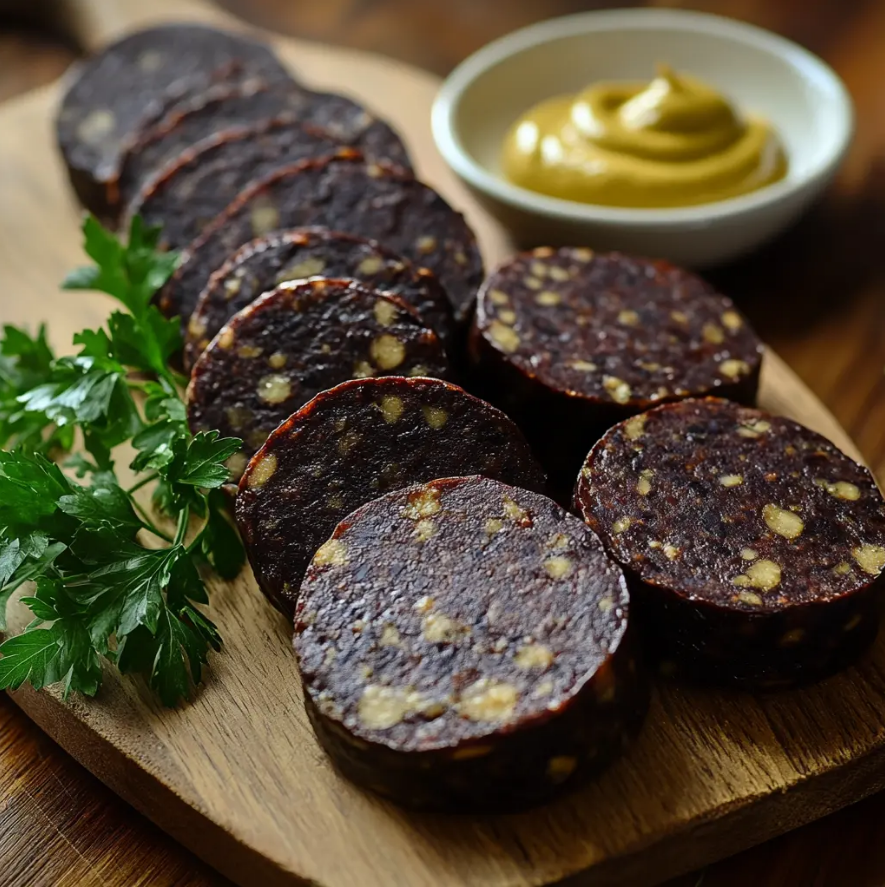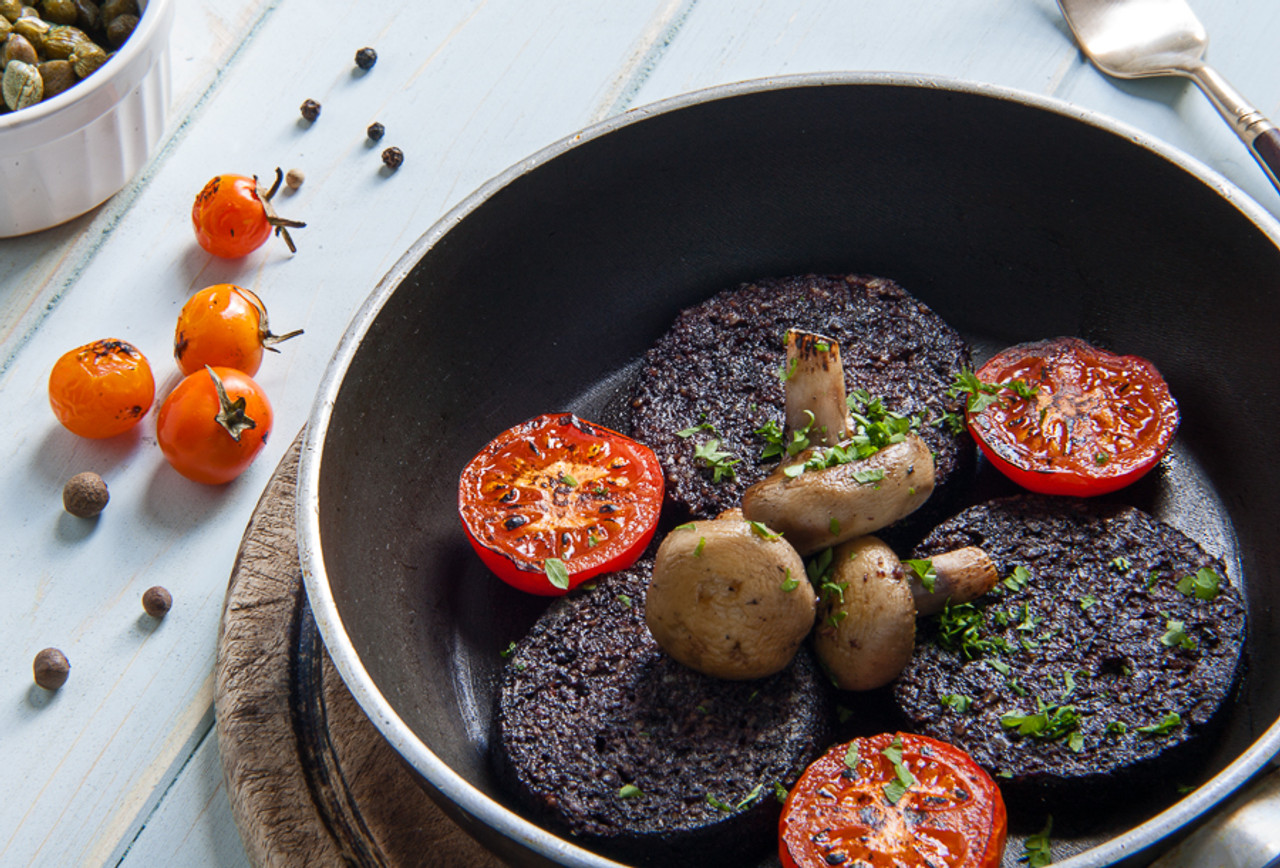Easy Homemade Scottish Black Pudding Recipe
Create rich and savory Scottish black pudding! This recipe includes essential tips and variations to suit your taste.
Dec 25, 202419.5K Shares260.9K Views

Scottishblack pudding is a deeply rooted delicacy in Scottish cuisine, often enjoyed as part of a hearty breakfast or added to modern dishes for a unique, savory flavor.
Made from blood, oatmeal, and spices, black pudding offers a rich and satisfying texture. Crafting black pudding from scratch allows you to connect with this tradition and enjoy a delicious, homemade result.
This recipe breaks down each step to make it easy to follow, with clear measurements and practical tips. For those who love traditional Scottish flavors or enjoy experimenting in the kitchen, this black pudding recipe brings a genuine taste of Scotland right into your home.
What Is Scottish Black Pudding?
Scottish black pudding is a type of blood sausage crafted from pork or beef blood, coarse oatmeal, fat, and spices. Originally created as a way to use every part of the animal, it reflects Scotland’s philosophy of resourceful cooking.
Scottish black pudding is typically made with steel-cut oats, giving it a unique, hearty texture that sets it apart from other blood sausage varieties.
Though often served at breakfast, black pudding is versatile enough to complement a range of meals. From pairing with seafood to adding it to salads, Scottish black pudding brings a rich and savory depth to many dishes.
Fun Facts About Black Pudding
- Historical Roots: Black pudding is one of the world’s oldest sausages, with variations appearing throughout Europe as early as ancient Greece. Each region has developed its own version, and in Scotland, black pudding has a particularly strong place in culinary tradition.
- Not Just for Breakfast: Once reserved for breakfast plates, black pudding is now enjoyed in various ways. Chefs around the world incorporate it into dishes like scallops with black pudding or salads with a savory twist.
- A Sporting Tradition: There’s even a black pudding throwing contest held annually in Ramsbottom, England, where participants toss black puddings at Yorkshire puddings in a lighthearted celebration of these classic foods.
- Nutritional Value: Black pudding is rich in iron, protein, potassium, and other essential nutrients, making it a satisfying choice when eaten in moderation.
Ingredients
- 50 g dried pig's blood(or fresh if available)
- 350 ml water(for rehydrating dried blood)
- 150 g pork back fat, diced while frozen
- 1/4 large onion, finely diced
- 190 g porridge oats, dried and blitzed in a food processor
- 25 g pearl barley, cooked and drained
- 2 g black pepper
- 1 g mace
- 3 g ground coriander
- 5 g salt
- Black pudding casings(or use a loaf pan lined with parchment paper as an alternative)
How To Make Scottish Black Pudding At Home
Step 1: Preparation
- Prepare Blood and Oats: If using dried pig’s blood, rehydrate it with 350 ml of water, whisking to ensure smooth consistency. Soak oats briefly or blitz them in a food processor to achieve a coarse texture.
- Cook Pearl Barley: Cook 25 g of pearl barley according to package instructions, typically for about 1 hour, then drain thoroughly.
Step 2: Mixing Ingredients
- In a large mixing bowl, combine the rehydrated blood, diced pork back fat, cooked barley, and diced onion.
- Add 190 g of oats, 2 g black pepper, 1 g mace, 3 g ground coriander, and 5 g salt. Mix until everything is evenly incorporated, but avoid over-mixing to keep the texture intact.
Step 3: Filling Casings Or Loaf Pan
- If using casings: Rinse casings under warm water, then fill them with the mixture using a spoon or sausage stuffer, leaving a bit of space to tie off the ends securely.
- If using a loaf pan: Line the pan with parchment paper, pour in the mixture, and smooth the top.
Step 4: Cooking Options
- Simmering Method: Place the filled casings in a large pot of simmering water (around 85°C/185°F) for 1.5 to 2 hours. Avoid boiling to prevent the casings from bursting.
- Baking in a Loaf Pan: Preheat the oven to 150°C (300°F). Place the loaf pan in a larger baking dish filled halfway with water, cover with foil, and bake for 1 to 1.5 hours.
Step 5: Cooling, Slicing, And Storing
Once cooked, allow the black pudding to cool to room temperature. Slice into rounds or loaf pieces. Store in the fridge for up to one week, or freeze portions for up to three months. When ready to serve, fry slices in a small amount of oil or butter until crispy.
Tips And Tricks For The Perfect Black Pudding
- Balance the Consistency: Avoid soaking oats for too long to prevent excess moisture. Using dried or blitzed oats will give a firmer texture.
- Seasoning Adjustments: Experiment with spices like cayenneor cloves to create a flavor profile suited to your taste. Black pepper, coriander, and mace provide a balanced flavor.
- Avoid Overfilling Casings: Leave a small amount of space in casings to prevent bursting during cooking.
- Consider Alternative Cooking Methods: Sous vide cooking is a reliable alternative if you have the equipment, as it minimizes the risk of bursting and keeps the pudding moist.
Regional Variations Of Black Pudding In Scotland
Black pudding recipes can vary across Scotland, reflecting local preferences and ingredient availability:
- Northern Scotland: Often includes spices like nutmegand cloves, giving it a subtly sweet flavor.
- Western Isles: Known for a minimalistic approach with fewer spices, allowing the flavor of the blood and oats to shine.
- Northeast Scotland: Barley is often added alongside oats, giving it a heartier texture and a nutty flavor.
- Border Regions: Influenced by English cuisine, black pudding here may have a stronger pepper profile.
These regional variations offer unique takes on black pudding, adding depth to Scotland’s culinary landscape.
Serving Suggestions And Pairings By Occasion
- Breakfast: Serve as part of a traditional Scottish breakfast with eggs, bacon, and tattie scones.
- Seafood Pairing: Try black pudding with seared scallops or haddock; its rich flavor complements delicate seafood beautifully.
- Salad Addition: Add slices of black pudding to salads with apples or greens for a savory, warm twist.
- With Whisky: Pair with a single malt whisky for a classic Scottish experience.
Nutritional Value And Health Benefits Of Black Pudding
Black pudding provides a range of nutrients, making it a nourishing choice when enjoyed in moderation:
| Nutrient | Amount |
| Iron | High |
| Protein | High |
| Potassium | Moderate |
| Zinc | Moderate |
| B Vitamins | Moderate |
Rich in protein and iron, black pudding can be a valuable addition to a balanced diet, especially for those needing an iron boost.
Dietary Variations And Alternatives
- Vegetarian Alternative: Use beet juice and black beans in place of blood, along with vegetable suet.
- Gluten-Free Option: Substitute oats with gluten-free steel-cut oats.
- Dairy-Free: Use full-fat coconut milk instead of regular milk for a creamy texture without dairy.
These adjustments allow those with dietary preferences to enjoy black pudding with slight modifications.
Recipe Adjustment Guide
For larger or smaller servings:
- Scaling Ingredients: Double each ingredient for 12 servings, or halve for a smaller batch. Adjust seasoning to taste, especially in larger quantities.
- Portioning for Freezing: Slice black pudding before freezing in individual portions to make it easier to reheat only what’s needed.
FAQs About Scottish Black Pudding
How Does Scottish Black Pudding Differ From Other Types?
Scottish black pudding uses coarse oats, making it heartier than other varieties.
What Alternatives Can I Use If I Don’t Have Casings?
A loaf pan lined with parchment works as a convenient alternative.
How Can I Adjust The Recipe For Dietary Restrictions?
For gluten-free, use gluten-free oats; for vegetarian, try beet juice and vegetable suet.
Can I Freeze Black Pudding, And How Long Does It Last?
Yes, black pudding freezes well for up to three months.
What Is The Best Method To Prevent Bursting During Cooking?
Cook at a gentle simmer or use sous vide to maintain integrity without bursting.
Conclusion
Scottish black pudding, a cherished dish rich in tradition, brings bold, savory flavors to any meal. Served in a classic breakfast, paired with seafood, or added to salads, it introduces an authentic taste of Scotland. Preparing it from scratch not only honors its heritage but also allows for unique, personal variations.
Enjoy the process of creating this Scottish classic, and explore how its rich flavors can add warmth and depth to your favorite meals.
Jump to
What Is Scottish Black Pudding?
Fun Facts About Black Pudding
Ingredients
How To Make Scottish Black Pudding At Home
Tips And Tricks For The Perfect Black Pudding
Regional Variations Of Black Pudding In Scotland
Serving Suggestions And Pairings By Occasion
Nutritional Value And Health Benefits Of Black Pudding
Dietary Variations And Alternatives
Recipe Adjustment Guide
FAQs About Scottish Black Pudding
Conclusion
Latest Articles
Popular Articles

